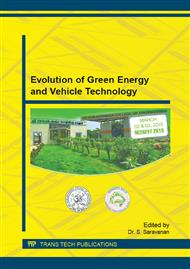p.33
p.44
p.51
p.60
p.64
p.70
p.79
p.87
p.93
Activated Carbon, Lithium Hydroxide, Calcium Hydroxide Scrubber for Carbon-Di-Oxide Capture from Exhausts of Vehicles
Abstract:
Vehicular pollution is one of the main reasons for air pollution in many cities. According to Industrial Environment Carbon, every gallon of gasoline produces 14% total volume of carbon dioxide, this will ultimately lead to air pollution and global warming [10]. To minimize the emission level, physical adsorption [4] can be used for the removal of organic molecule from exhaust gas stream by impulse collision. So our proposed system consists of a filter matrix bed, made of activated carbon, calcium hydroxide, lithium hydroxide [8,9]. Activated carbon is the most widely used adsorbent. It can adsorb a wide range of pollutants with varying dimensions by its broad pore distribution, micro and mesophores. Calcium group can naturally adsorb carbon component and get transformed into lime. Lithium hydroxide is widely used as carbon capturing material in space craft for adsorbing carbon dioxide exhaled by astronaut as a breathing scrubber. So collectively these three carbon sequestrating material can efficiently remove the pollutant by chemisorptions [2].
Info:
Periodical:
Pages:
64-69
Citation:
Online since:
November 2015
Price:
Сopyright:
© 2015 Trans Tech Publications Ltd. All Rights Reserved
Share:
Citation:


